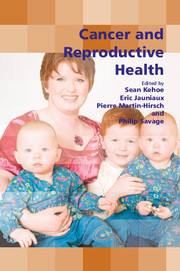Book contents
- Frontmatter
- Contents
- Participants
- Preface
- SECTION 1 Epidemiology, Genetics and Basic Principles of Chemotherapy and Radiotherapy
- SECTION 2 Fertility Issues and Paediatric Cancers
- SECTION 3 Gynaecological Cancers and Precancer
- SECTION 4 Diagnostic Dilemmas
- 13 Imaging techniques
- 14 Serum markers for gynaecological cancer in the reproductive years
- 15 Diagnostic dilemmas in cellular pathology
- SECTION 5 The Placenta
- SECTION 6 Non-Gynaecological Cancers
- SECTION 7 Multidisciplinary Care and Service Provision
- SECTION 8 Consensus Views
- Index
14 - Serum markers for gynaecological cancer in the reproductive years
from SECTION 4 - Diagnostic Dilemmas
Published online by Cambridge University Press: 05 October 2014
- Frontmatter
- Contents
- Participants
- Preface
- SECTION 1 Epidemiology, Genetics and Basic Principles of Chemotherapy and Radiotherapy
- SECTION 2 Fertility Issues and Paediatric Cancers
- SECTION 3 Gynaecological Cancers and Precancer
- SECTION 4 Diagnostic Dilemmas
- 13 Imaging techniques
- 14 Serum markers for gynaecological cancer in the reproductive years
- 15 Diagnostic dilemmas in cellular pathology
- SECTION 5 The Placenta
- SECTION 6 Non-Gynaecological Cancers
- SECTION 7 Multidisciplinary Care and Service Provision
- SECTION 8 Consensus Views
- Index
Summary
Introduction
The current trend of increasing life expectancy and advancing age at which women opt to have children suggests that the number of cancers presenting in pregnancy is likely to increase. The recent triennial Confidential Enquiry into Maternal Deaths in the UK reported the deaths of 81 women from cancer in pregnancy during 2003—05, compared with 28 in 2000—02. However, this increase in number was thought to be entirely due to a more intensive follow-up of the ‘late coincidental deaths’ identified through the Office for National Statistics (ONS) linkage system. Nine of these were attributable to gynaecological malignancies: four choriocarcinomas, two ovarian and three vulval or uterine cancers.
Conservative management of gynaecological cancer with fertility preservation is becoming increasingly important in the reproductive age group. This requires early detection and effective monitoring and follow-up. In addition, diagnosis of cancer in pregnancy is complicated by physiological changes, which tend to mask signs and symptoms, together with the limitations of imaging and other investigative modalities. In such a situation, serum tumour markers, despite difficulties in interpretation, play an important role. This chapter focuses on the various tumour markers relevant to gynaecological malignancies in premenopausal women and their role in management.
Tumour markers
Tumour markers are molecules or substances produced by or in response to neoplastic proliferation and which enter the circulation in detectable amounts. They indicate the likely presence of cancer or provide information about its behaviour.
Keywords
- Type
- Chapter
- Information
- Cancer and Reproductive Health , pp. 155 - 178Publisher: Cambridge University PressPrint publication year: 2008



